Each year, several billion tonnes of mineral dust are lofted into the atmosphere from the world’s arid regions, making dust one of the most abundant types of aerosol particles in the atmosphere. Now, scientists are learning that tiny bits of dust from the hottest and driest parts of the Earth are a surprisingly large driver in forming the delicate, wispy ice clouds known as cirrus in the cold, high altitudes of the atmosphere.
News
Icy Cirrus Clouds Born From Desert Dust
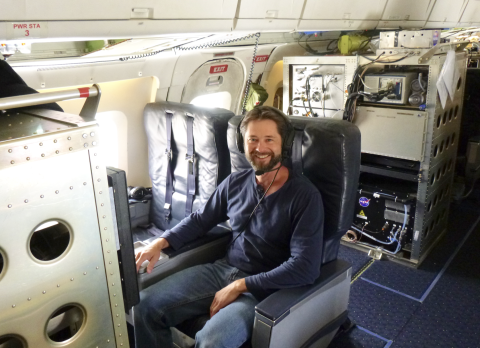
Southern Ocean confirmed as strong carbon dioxide sink

Research published in recent years has suggested the Southern Ocean might be absorbing less carbon dioxide (CO2) from the atmosphere than previously thought. But a new study published this week in the journal Science confirms the role of the Southern Ocean as a significant carbon sink.
Aircraft Reveal a Surprisingly Strong Southern Ocean Carbon Sink

The Southern Ocean is indeed a significant carbon sink — absorbing a large amount of the excess carbon dioxide emitted into the atmosphere by human activities — according to a new study led by the National Center for Atmospheric Research (NCAR).
NASA-supported Study Confirms Importance of Southern Ocean for Absorbing CO2

Observations from research aircraft show that the Southern Ocean absorbs much more carbon from the atmosphere than it releases, confirming it is a very strong carbon sink and an important buffer for the effects of human-caused greenhouse gas emissions, according to a new, NASA-supported study.
Douglas DC-8 experimental da NASA pousara hoje no Aeroporto do Recife
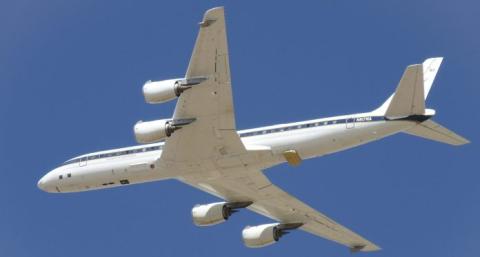
O Douglas DC-8 da NASA, uma aeronave experimental pertencente ao Centro de Pesquisa em Voo Armstrong, chegara hoje as 18h15 no Aeroporto Internacional do Recife, representando a missao ATom e tambem um trafego aereo diferente nos dias atuais, visto que poucos DC-8 continuam operando no mundo.
Avion de la Nasa sobrevolo la Antarctica
Atmospheric Tomography Mission (Atom) es el proyecto de investigacion por el cual viajaron alrededor de 44 cientificos desde la Nasa en el avion DC-8 que llego a tierra magallanicas este lunes 7 de mayo con la mision principal de sobrevalor la Antarctica.
Avión de la Nasa sale a escanear la atmósfera sobre la Antártica

"El vuelo está planeado para durar aproximadamente 10 horas, saliendo a las 8 y retornando a Punta Arenas cerca de las 18. Usualmente llevamos alimentos, ya sea almuerzos en cajas o comprados en una tienda. Tenemos un microondas a bordo", cuenta Rebecca Hornbrook, investigadora del Centro Nacional de Investigación Atmosférica (NCAR) de Boulder, Colorado.
Cloudy with a chance of chemistry

The most important question at the daily briefing for NASA’s Atmospheric Tomography, or ATom, mission is: What are we flying through next? For the 30 scientists plus aircraft crew loaded up on NASA’s DC-8 flying research laboratory on a 10-flight journey around the world to survey the gases and particles in the atmosphere, knowing what’s ahead isn’t just about avoiding turbulence. It’s also about collecting the best data they can as they travel from the Arctic to the tropics then to the Antarctic and back again.
NASA’s flying laboratory seeks to understand atmosphere
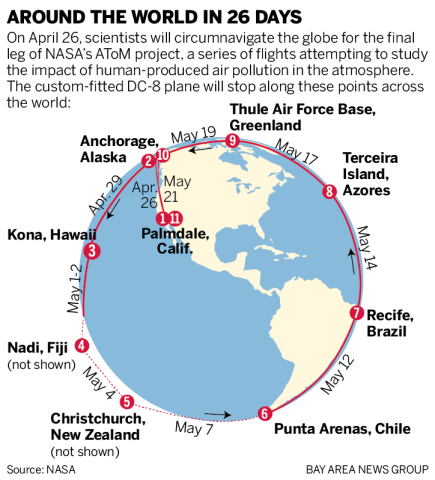
A suite of scientists are zig-zagging across the globe in a flying laboratory, a DC-8 research plane retrofitted to gulp the air we breathe. Soaring from the Arctic to Antarctica on flights crammed with valves, funnels and testing equipment, scientists from NASA Ames Research Center in Mountain View and other labs capture greenhouse gases and gather data about pollution in Earth’s atmosphere. The final leg of the four-part expedition of the Atmospheric Tomography Mission, also known as ATom, will take off from Palmdale Thursday. Their mission: Give scientists important information about changes in the composition of gases in the atmosphere.
NASA's World Tour of the Atmosphere Reveals Surprises Along the Way

Two thirds of Earth's surface are covered by water — and two thirds of Earth's atmosphere reside over the oceans, far from land and the traditional ways that people measure the gases and pollutants that cycle through the air and around the globe. While satellites in space measuring the major gases can close some of that gap, it takes an aircraft to find out what's really happening in the chemistry of the air above the oceans. That's where NASA's Atmospheric Tomography (ATom) mission comes in.
Organic aerosols in remote areas have shorter lives than scientists assumed
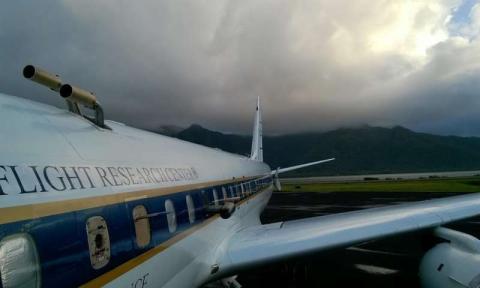
Ambient aerosols – those tiny mixtures of liquids and solids suspended in air – play important roles in Earth's climate, so much so that scientists are heading to remote locations to better understand them.
NOAA, NASA team up again to investigate the atmosphere over Antarctica

Thirty years after NASA and NOAA launched a groundbreaking airborne campaign to study the Antarctic ozone hole, the two federal science agencies have once again joined forces over the world’s highest, driest and coldest continent to sniff out the secrets of the atmosphere.
Global Airborne Mission to Make Ozone Hole Detour

Atmospheric researchers depart this month on NASA's DC-8 research aircraft on their third survey of the global atmosphere. Taking place for the first time in Northern Hemisphere fall, the season gives them the unique opportunity to make a detour from their previous flight paths to fly underneath the Antarctic ozone hole.
A CAT scan for the Earth: CU, NOAA scientists are looping around the globe in a NASA airliner to measure greenhouse pollutants

Scientists treating Earth as a feverish patient are giving it the equivalent of a CAT scan, targeting short-life pollutants that spur climate change to try to find a remedy that dials back the heat.
Lab-in-a-Plane Making Four Laps Around the Globe
The project is called the Atmospheric Tomography Mission (the acronym AToM is pronounced AY-tom, since it's not actually an atomic study). Basically, it's a DC8, crammed full of samplers and sensors, constantly measuring things like methane, carbon dioxide, and pollutants, as the plane flies around the globe, zig-zagging up and down between 500 ft and 30-40,000 feet.
NASA Plane Lands At Nadi Airport

In a first for Fiji, the United States National Aeronautics and Space Administration’s (NASA) DC-8 Airborne Science Laboratory aircraft landed at the Nadi International Airport on Saturday.
NASA research flight around the world pauses in Anchorage
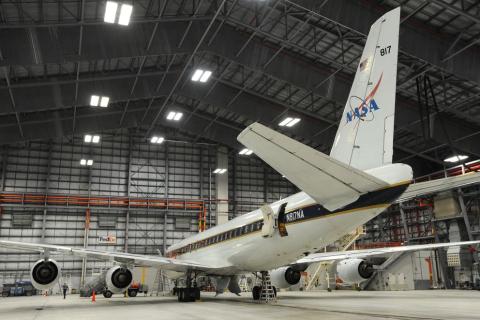
Air pollution can be obvious when it is concentrated around cities and industrial centers. But what about the big parts of the atmosphere that are far from freeways or factories? Finding the answer to that question is the purpose of a NASA project that is sending an equipment-laden and scientist-packed DC-8 passenger jet around the world, over the middle of the Pacific, Atlantic and Arctic oceans, with brief stops in Anchorage and other locations.
NASA Airborne Mission Chases Air Pollution Through the Seasons

Earth is a planet that breathes with the seasons. In winter months atmospheric gases and air pollution accumulate, waiting dormant until spring and summer bring sunshine and plant-life, sparking transformations that change the make-up of gases in the atmosphere. A NASA airborne mission will take a world-wide survey of these seasonal transformations by flying from the heart of winter in the Northern Hemisphere, down into the sunny summer in the Southern Hemisphere and back again.
UCI’s Don Blake travels the world searching for what we breathe

Strapped into a NASA-modified DC-8, UC Irvine professor Donald Blake fiddles with some knobs on a crate that holds canisters that contain the key element of his career: Air.
NASA's flying laboratory going low over Lauder, Central Otago
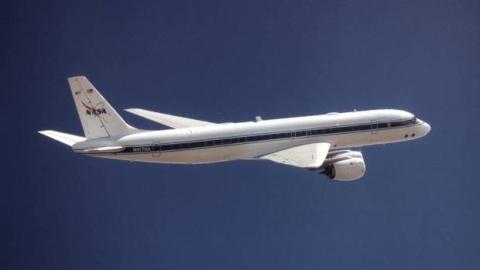
A NASA research plane carrying 42 scientists will fly over Central Otago next week on a mission to survey the atmosphere and measure pollution. NIWA atmospheric scientist Dave Pollard said the Atmospheric Tomography Mission (ATom) was the first of its kind to survey the atmosphere over the oceans, measuring how much pollution survived and assessing how the environment had changed as a result.
NASA's Airborne Mission to Explore the Global Atmosphere

The Atmospheric Tomography, or ATom, mission is the first to survey the atmosphere over the oceans. Scientists aboard NASA's DC-8 flying laboratory will journey from the North Pole south over the Pacific Ocean to New Zealand and then across to the tip of South America and north up the Atlantic Ocean to Greenland. ATom will discover how much pollution survives to the most remote corners of the earth and assess how the environment has changed as a result.
Airborne Study Surveys Greenhouse Gases in World Tour

The first deployment of one of NASA's most ambitious research studies of Earth's atmosphere will take place this July and August. The Atmospheric Tomography mission will take off aboard the agency's DC-8 flying laboratory on a 26-day journey from the North Pole down the Pacific Ocean to New Zealand and then across to the tip of South America and back north up the Atlantic Ocean to the Arctic.
NASA's ATom Mission is Flying Around the World in 26 Days
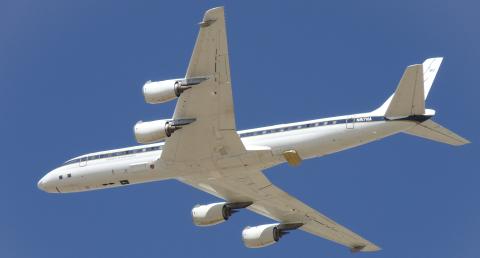
It's not a strict circumnavigation of the world, but NASA's Atmospheric Tomography, or ATom, mission to fly down the Pacific Ocean then up the Atlantic is about as close as it gets. Beginning July 28, 2016, NASA's flying laboratory aboard the DC-8 aircraft will journey with 42 scientists and operations crew on a 26-day journey from nearly pole to pole and back again. The first of four deployments that will take place over the next three years, they'll be measuring a suite of more than 200 gases as well as airborne particles from the remotest parts of the atmosphere to better understand the processes that govern how various greenhouse gases cycle around the world.
New Mission to Provide Snapshot of ‘Average’ Atmosphere

A new NASA Earth Venture mission called the Atmospheric Tomography Mission (ATom) aims to provide a snapshot of the average atmosphere. ATom will systematically measure reactive gases and aerosols over the Atlantic and Pacific Oceans, where the atmosphere is relatively clean and sensitive to change.
Disclaimer: This material is being kept online for historical purposes. Though accurate at the time of publication, it is no longer being updated. The page may contain broken links or outdated information, and parts may not function in current web browsers. Visit https://espo.nasa.gov for information about our current projects.

